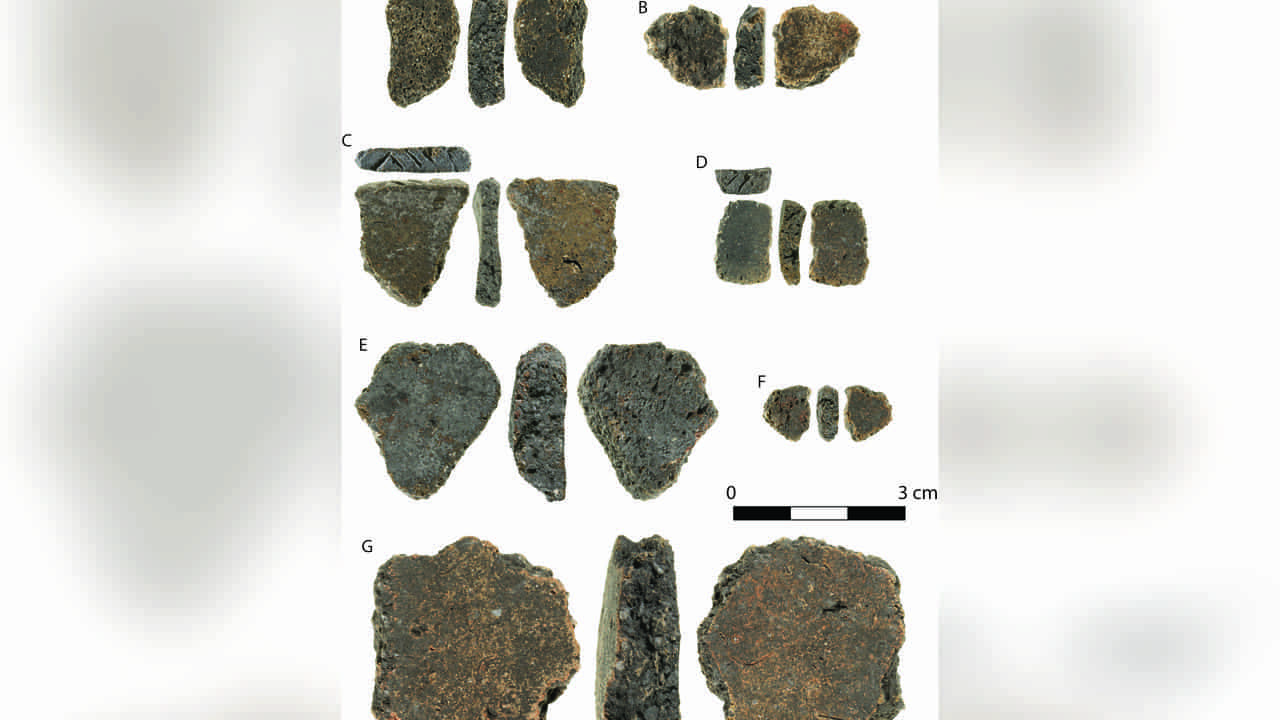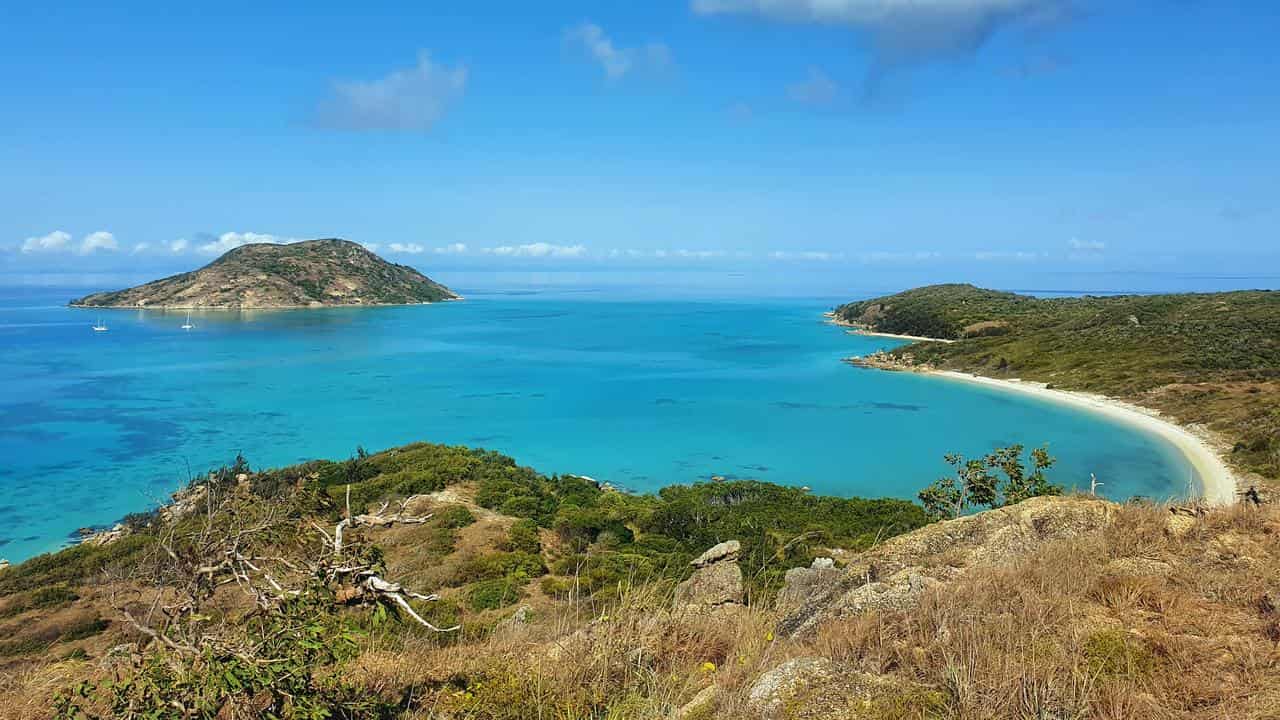
An archaeological dig on Jiigurru, a tropical island in the Great Barrier Reef, has found the oldest pottery made in Australia.
When archaeologists excavated a 2.4-metre-deep midden, they were expecting to find evidence of occupation, such as the remains of shellfish and fish collected and eaten by people on the island.
But what they weren't expecting and were delighted to find were dozens of pottery shards dated between 2000 and 3000 years old, less than a metre below the surface.
The ceramics were discovered in an excavation on Jiigurru conducted by the Australian Research Council Centre of Excellence for Australian Biodiversity and Heritage (CABAH) in partnership with the Dingaal and Ngurrumungu Aboriginal communities, for whom Jiigurru holds significant cultural importance.
CABAH chief investigator Distinguished Professor Sean Ulm from James Cook University said the discovery revealed that Aboriginal communities in North Queensland had connections with pottery-making communities of New Guinea.
The pottery is dated between 1800 and 2900 years ago.
Prof Ulm told AAP the only comparable ceramics in this country have been found on the Torres Strait Islands, where they've dated about 24 pieces to around 1700 years ago.
"Pottery elsewhere in northern Australia really only becomes prominent with Macassan seafaring and voyaging from Southeast Asia and working with traditional owners across the Top End to harvest trepang - and that only dates to the last 400 years," he said.

"The age of the pottery at Jiigurru overlaps with pottery production that we know about elsewhere around the Coral Sea that is happening at the same time.
"Around southern New Guinea pottery is being made around the same time from around 3000 years ago and elsewhere in the Pacific, like Vanuatu, New Caledonia and Fiji."
Analysis of the ceramics indicates the pottery was locally produced using clays and tempers sourced from Jiigurru.
"These vessels are being made on country," Prof Ulm said.
"They're not being made in New Guinea or somewhere else and traded ... and that means that those old people had that knowledge of how to make that pottery."
Excavation, by its nature, is destructive.
"When you dig into a cultural place, you can't put it back exactly the way you took it out," Prof Ulm said, explaining that meant the team only dug a small space.
"So we've only got a very small window into what those old people were doing in the past from that excavation."
They found 82 pieces of pottery, with an average size of 18mm.
A few of the pieces have maker's marks, but Professor Ulm said they can't distinguish whether they were made using coils or a paddle and anvil technique, the two methods of making pottery widely used in southern New Guinea and the Pacific at the time.
"Quite a few of the pieces of pottery have some decoration on the neck, some of them have pigment and quite a few of them have little incisions with diagonal lines or little crosses," he said.
"So people are taking care in making these vessels."
The pieces are only a couple of millimetres thick.
"They're not just experimenting with how to make pottery, they knew how to make it," Prof Ulm said.
"The vessel sizes we've been able to reconstruct have an opening at the top of up to 20 centimetres, so these could be quite sizeable vessels ... that takes a lot of skill.
"So it's not just people practising, these are people who know how to make pots, they have that expert knowledge of how to do this."
The pottery has been identified as low-fired, a technique to harden clay that is still used today.
"In parts of the Pacific and Melanesia often rocks are heated up and the vessels are placed on those rocks and sometimes covered to create kind of an oven," Prof Ulm said.
"Commonly, when you find pieces of pottery in archaeological sites, it's normally fragments, you rarely find whole vessels."

CABAH chief investigator Professor Ian McNiven, from Monash University, said the evidence points to a history of deep connections across the Coral Sea, facilitated by advanced canoe voyaging capacity and open-sea navigation skills.
“These findings not only open a new chapter in Australian, Melanesian, and Pacific archaeology but also challenge colonialist stereotypes by highlighting the complexity and innovation of Aboriginal communities,” he said.
“The discovery adds a new layer to our understanding of Jiigurru and Indigenous Australians’ role in the broader network of maritime exchange and cultural interaction across the Coral Sea.”
Professor McNiven says Jiigurru marks the southern boundary of ancient international maritime networks that linked eastern north Queensland, southern New Guinea and the Torres Strait.
“These networks facilitated the exchange of objects and ideas between Australian and New Guinean coastal communities over the past 3000 years," he said.
"While some objects, like cone-shell body adornments and bamboo smoking pipes, indicate widespread sharing of culture and ideas, others, such as pottery, also suggest the sharing of technology.”
Jiigurru has historically been used as a place for ceremony, initiation, gathering, and knowledge transmission.
Dingaal clan member and Walmbaar Aboriginal Corporation chairperson Kenneth McLean said the partnership with academics had been a valuable exercise.
“Working in collaboration with archaeologists and traditional owners and working on country is something that's never been done before for my people, where we work together on country, sharing each other's story on country," he said.
"And not only sharing this story from our people, the Old People, and from the archaeology side, scientifically, which is a good outcome.
"We can look after the country together.”
Ngurrumungu Elder Brian Cobus said, when conducted in true partnership, research projects help everyone better understand how to look after country.
"Every bit of knowledge we gain helps us tell the story of country," he said.
The researchers are unsure exactly what the pottery was used for.
"In the future we're doing what we call residue studies to see if there's any residues or oils embedded in the surface of the pottery that might be able to tell us whether the old people were using it for cooking food, for example, or whether it was seafood or plant food," Prof Ulm said.
"That would be really exciting if we're able to do that."









